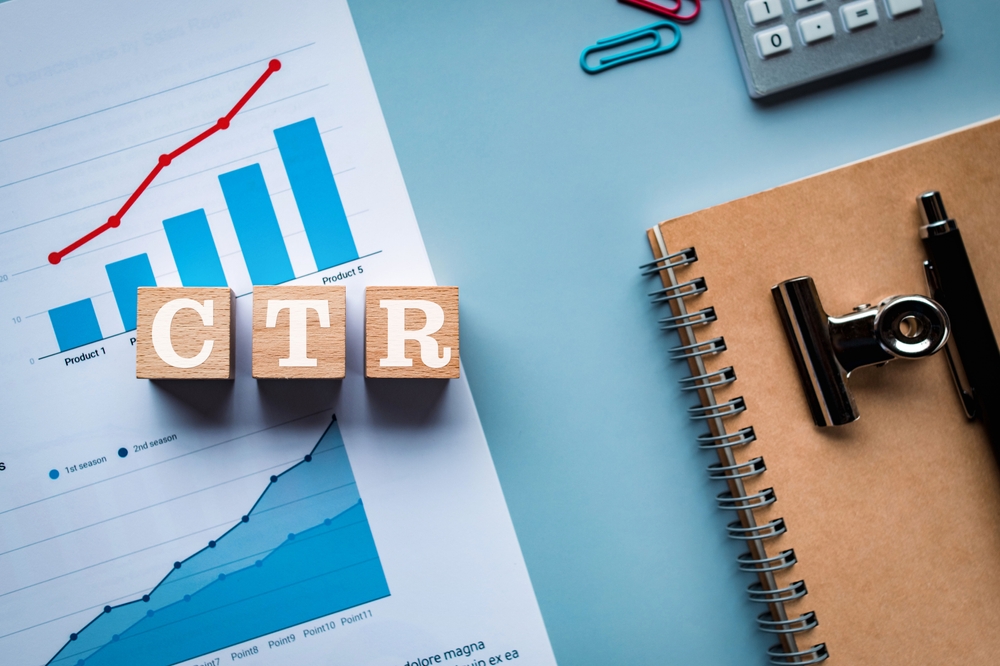What is Click-Through Rate (CTR)?
Click-Through Rate (CTR) measures the percentage of people who click on a link, ad, or search result after seeing it. It’s a key performance metric that reflects how effective your digital content is in prompting users to take action. The formula to calculate CTR is:
CTR=(Number of Clicks x Number of Impressions)×100\text{CTR} = \left( \frac{\text{Number of Clicks}}{\text{Number of Impressions}} \right) \times 100
For example, if your ad received 1000 impressions and 50 clicks, your CTR would be:
CTR=(501000)×100=5%\text{CTR} = \left( \frac{50}{1000} \right) \times 100 = 5\%
Why CTR is Crucial in Digital Marketing
CTR is more than just a number; it’s a key indicator of how well your content or ads resonate with your audience. Here’s why it’s so important:
- Performance Indicator: A high CTR generally indicates that your content or ads are relevant and engaging to your target audience. Conversely, a low CTR suggests that you may need to reassess your strategy.
- SEO Impact: For organic search results, a higher CTR can signal to search engines that your content is valuable and relevant. This can lead to better rankings and increased visibility in search results.
- Cost Efficiency: In PPC campaigns, a higher CTR often results in a lower cost per click (CPC), as search engines and ad platforms reward more engaging ads with lower costs. This can lead to a more cost-effective advertising strategy.
CTR Across Different Channels
CTR can vary significantly depending on the channel and type of content. Let’s break down how CTR functions in various digital marketing contexts:
Organic Search CTR
Organic CTR refers to the percentage of clicks on a website’s listing in search engine results pages (SERPs) relative to the number of times it is shown. Key insights include:
- Top Position Advantage: According to Backlinko, the average organic CTR for the top position in Google search results is approximately 27.6%. This figure drops sharply as you move down the rankings. For instance, the 10th position receives nearly 10 times fewer clicks than the top spot.
- Factors Influencing CTR: Several factors impact organic CTR, including the length of your title tag, relevance of keywords, and the sentiment conveyed in your titles. Crafting compelling and keyword-rich titles can improve your CTR.
- CTR and Rankings: A higher CTR can signal to Google that your content is valuable, potentially leading to improved rankings. Search engines use CTR as a relevance signal, which can influence how your content is positioned in search results.
Paid Search CTR
Paid search ads, such as those on Google AdWords or Bing Ads, also rely on CTR to gauge performance. Here’s what you need to know:
- Typical CTR: Paid search ads typically have a CTR that exceeds 1%, with variations depending on factors such as ad format, placement, and targeting. For instance, ads in the top positions often have higher CTRs than those in lower positions.
- Impact on Costs: A higher CTR in PPC campaigns can lead to lower costs per click. Ad platforms often reward more engaging ads with reduced CPC, making it crucial to focus on ad quality to maximize cost efficiency.
- Ad Optimization: Improving your ad copy, targeting specific keywords, and refining your audience segmentation can enhance your CTR in paid search campaigns.
Display Ads CTR
Display ads, including banner ads and sidebar ads, tend to have lower CTRs compared to search ads. Key points include:
- Lower CTR Rates: Display ads often have CTRs below 0.1%, reflecting the fact that they’re generally less targeted and may not capture user intent as effectively as search ads.
- Ad Format and Placement: The format of your display ad and its placement on a website can significantly impact CTR. Experimenting with different designs and locations can help identify what resonates best with your audience.
- Audience Targeting: Effective audience targeting can improve CTR for display ads. Using demographic, behavioral, and contextual targeting can help ensure your ads reach users who are more likely to engage.
Email Marketing CTR
In email marketing, CTR measures the effectiveness of your email campaigns in driving recipients to take action. Consider the following:
- Average CTR: Email marketing CTRs vary, but industry averages often range from 1% to 5%. Factors such as email subject lines, content relevance, and call-to-action (CTA) clarity influence CTR.
- Personalization and Segmentation: Personalizing email content and segmenting your audience based on their interests and behaviors can significantly boost CTR. Tailored messages that address specific needs or preferences are more likely to engage recipients.
- Optimizing CTAs: Clear, compelling CTAs are crucial for improving email CTR. Ensure that your CTAs are prominent, relevant, and offer value to the reader.
Strategies to Improve CTR
Improving CTR involves a combination of optimization techniques and a deep understanding of your audience. Here are some actionable strategies:
Optimize Titles and Meta Descriptions
- Title Tags: Craft compelling and concise title tags that include relevant keywords. Make sure your titles are engaging and accurately reflect the content of your page.
- Meta Descriptions: Write persuasive meta descriptions that provide a clear overview of what users can expect from your content. Include a call-to-action to entice users to click.
Enhance Ad Creatives
- Visual Appeal: Use eye-catching visuals and compelling ad copy to grab attention. Experiment with different designs to see what resonates best with your audience.
- Relevance: Ensure that your ad creatives are relevant to the keywords or audience segments you’re targeting. Misaligned ads can lead to lower CTR.
Target the Right Audience
- Audience Segmentation: Use data-driven insights to segment your audience and tailor your content or ads to their preferences and behaviors. Targeting the right audience can improve engagement and CTR.
- Geo-Targeting: Implement geo-targeting to reach users in specific locations. This can be particularly effective for local businesses or campaigns with regional relevance.
A/B Testing
- Test Variations: Conduct A/B tests on your titles, ad copy, and visuals to identify what drives the highest CTR. Testing different elements allows you to make data-driven decisions and optimize performance.
- Analyze Results: Continuously analyze the results of your tests to understand what works best. Use these insights to refine your strategy and improve CTR over time.
Also Read: Unlocking Global Success-Power of International SEO Services
Conclusion
Click-Through Rate (CTR) is a critical metric in digital marketing, reflecting how well your content or ads engage your audience and drive action. Whether you’re focused on organic search, paid search, display ads, or email marketing, understanding and optimizing CTR can significantly impact your overall success.
By leveraging the insights provided in this blog post and implementing effective strategies, you can enhance your CTR, improve performance, and achieve your marketing goals. Remember, a higher CTR not only indicates better engagement but also contributes to cost efficiency and improved rankings. Embrace the power of CTR and watch your digital marketing efforts thrive.





